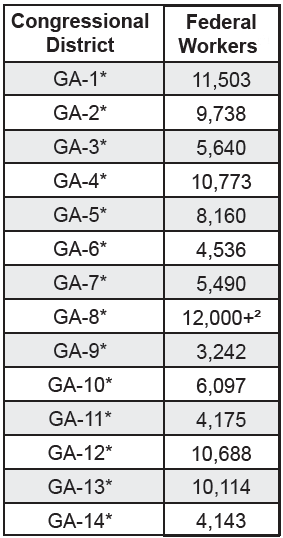Federal workers are vital to Georgia’s economy
The administration is targeting federal employees who serve Georgia’s veterans, seniors and farmers; keep our airports and national parks safe; and carry out critical missions such as medical research and disease prevention. Federal employees and their families are also our neighbors who live, work and send their children to Georgia schools. The administration’s sweeping cuts to the federal workforce are felt in every single Georgia community.
 Who are federal employees in Georgia?
Who are federal employees in Georgia?
The federal workforce consists of roughly 3 million employees across the United States.[1]
- Georgia is home to 106,467 federal employees,[2] about 2% percent of the state’s total non-farm employment.[3]
- The federal government is a larger employer in Georgia than:
- Congressional metro area, percentage of federal workforce in Georgia[6] living in:
- Atlanta Metro 54,295 (51%)
- Augusta 11,601 (10.9%)
- Savannah 5,687 (5.3%)
- Columbus 5,330 (5%)
- Major federal employers in Georgia include the Centers for Disease Control,[7] which in February employed about 13,000 people, as well as strategic military facilities which includes Robins Air Force Base with approximately 17,000 federal civilian employees.[8]
Attacking federal employees means cutting Georgia jobs, services, and specialized expertise that are difficult to replace
Federal employees carry out agency missions that underpin our entire economy and do jobs that often require very specific experience or training. For example, with 2,700 employees, the Department of Veterans Affairs in Augusta provides critical support to Georgians who have served our country.[9] On average, federal employees have more experience and education than the workforce at large.
- Over 42% of federal workers are over age 50, compared to 33% of the overall workforce.[10]
- Nearly 50% of federal employees have been in public service for over a decade.[11]
- About 54% of federal employees have a bachelor’s or advanced degree, compared to about 40% in the overall workforce.[12]
Attacking federal employees means attacking large numbers of veterans, women, workers with disabilities, workers of color and union members
Due to strong equal employment policies, union contracts guaranteeing equal pay for equal work, and programs to recruit those who’ve completed military service, the federal workforce is very diverse.[13] Historically, federal employment has offered important opportunities to women and workers of color—in some states playing a central role in building the Black middle class.
- In Georgia,
- 48% of the federal workforce are women
- 44% of the federal workforce is Black
- 25% of the federal workforce are Black women
- 6% of the federal workforce is Latino
- 9% of the federal workforce is disabled
- 30% of federal workers are veterans, compared to only 5% of the overall workforce; 36,500 of Georgia’s federal workers (34%) are veterans and military spouses.[14]
- 21% of federal workers self-identify as disabled, versus the overall U.S. disability rate of 5%.[15]
- Black workers make up 19% of the federal workforce, versus 13% of the overall workforce.[16]
- About 23% federal workers and over 60% of postal workers are represented by a union, compared to 11.1% of the overall workforce.[17]
Georgia’s federal workers are standing up against illegal, unconstitutional attacks to defend critical services
Right now Georgia federal workers and their unions are defending their obligations to the public and the US Constitution as they challenge illegal firings[18] and funding freezes, while maintaining vital services.
What can you do?
Call your member of Congress to express your concerns!
Endnotes
*Because of redistricting, the districts above may be different than the boundaries of the current Congress (119th)
[1] New resource calculates how many federal workers live in every state, county, and congressional district. EPI
[2] How many federal employees live in your state? EPI.
[3] US Georgia economy at a glance, “total nonfarm.” Bureau of Labor Statistics (BLS), Southeast Information Office.
[4] State of Georgia FY 2024 workforce report. Includes hourly, temporary, and full-time, in FY 2024.
[5] Metro Atlanta Chamber Atlanta Top Employers (2022-2023), Delta FTE headcount for Metro Atlanta.
[6] How many federal employees live in your state? EPI
[7] Mass layoffs at Atlanta-based CDC spread shock. Atlanta Journal Constitution.
[8] 2023 Robins Air Force Base economic impact statement.
[9] VA, with a big Augusta presence, to lose 72,000 jobs in DOGE cuts. WRDW-TV/WAGT-TV-Gray Local Media Station.
[10] A profile of the 2023 federal workforce. Partnership for Public Service (PPS)
[11] A snapshot of the federal workforce that is under attack from the Trump administration. PPS
[12] Ibid.; Census Bureau releases new educational attainment data. US Census Bureau.
[13] Threats against federal workers impact communities in every state. National Partnership for Women & Families
[14] Employment situation of veterans-2023. BLS; Trump’s federal workforce cuts. EPI
[15] A profile of the 2023 federal workforce. Partnership for Public Service (PPS); Employment status of the civilian population by sex, age, and disability status. BLS
[16] A snapshot of the federal workforce that is under attack from the Trump administration. PPS
[17] Union membership by sector and demographic group, federal, 2024. Unionstats.com; Membership and coverage rates, 1983-2024 (2024), postal service workers. Unionstats.com. Share represented by a union. EPI
[18] Federal court finds firing of probationary federal employees illegal. American Federation of Government Employees








